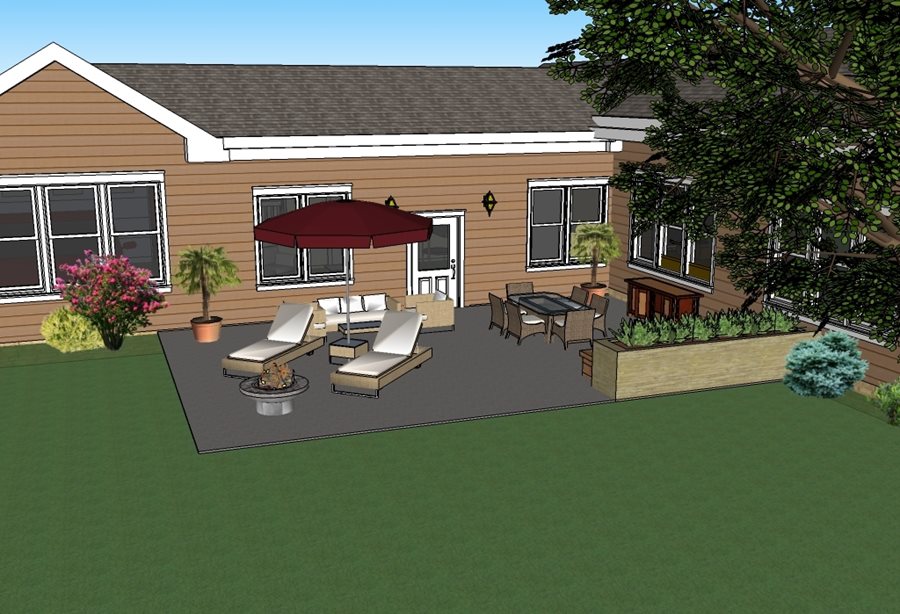What is a Patio Layout?
A patio layout is the design plan for a designated outdoor living space that typically involves paving stones, bricks, or concrete pavers. This space may be used for several outdoor activities such as dining, socializing, or relaxation.
A well-designed patio layout can enhance the aesthetics of a property and add value to it. Moreover, it provides an opportunity to create an outdoor haven that complements the homeowner’s lifestyle. Therefore, homeowners should take time to plan and design the perfect patio layout that meets their space, style, and functionality needs.
When developing a patio layout, the first consideration should be the available space. Homeowners should assess their outdoor space to determine the size and shape of the patio. The size of the patio layout can vary depending on the number of occupants and the activities that may take place. A small, cozy space can be utilized for intimate gatherings, whereas a larger space is better suited for big group events.
The layout design should also incorporate the homeowner’s style preferences. Consideration must be given to the color, texture of materials, and lighting. Additions such as lush potted plants, garden beds, and outdoor lighting can create a relaxing oasis for homeowners.
Following the design process, careful consideration must be given to building codes and regulations. The patio layout must meet the local building codes and regulations. A permit may be required, and homeowners should consult with professional landscape contractors to ensure compliance.
In summary, a well-designed patio layout enhances the aesthetics of a property, adds value, and creates an outdoor haven that complements the homeowner’s lifestyle. The key considerations when designing a patio layout are the available space, style preferences, building codes and regulations, and homeowners’ needs. With a carefully planned and executed patio layout, homeowners can enjoy their outdoor living space for many years to come. If you think about the patio layout in advance, you can also think about good types of patio furniture, patio rug, privacy etc.
Benefits of Planning a Patio Layout
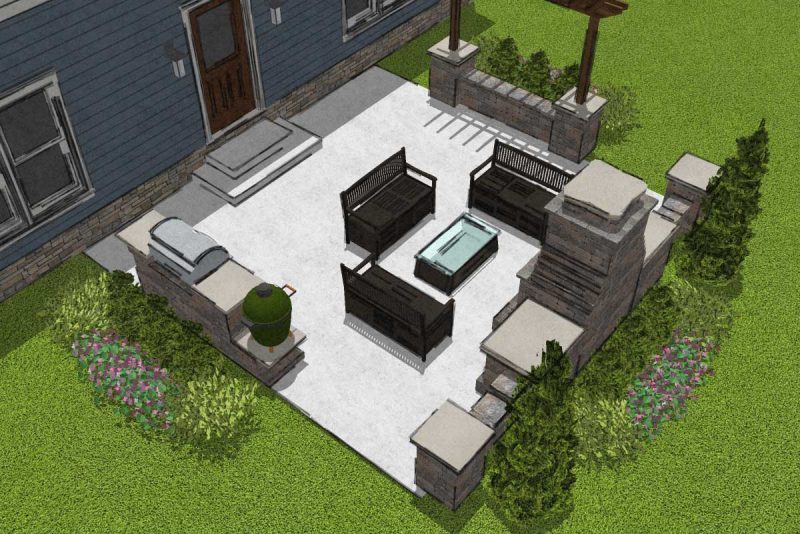
A well-designed patio layout is not just an outdoor living area; it is an extension of your home where you can relax, entertain, and enjoy the beautiful outdoor space. Planning a patio layout can bring many benefits to the homeowner, both aesthetically and functionally.
Firstly, a patio layout provides homeowners with additional living space, allowing them to expand the living area of their home and create an outdoor oasis. Whether it is a cozy space for intimate gatherings or a larger space for big group events, a well-planned patio layout can be designed to meet the homeowner’s needs.
Additionally, planning a patio layout can enhance the aesthetics of the outdoor space and the beauty of the surrounding landscape. The right combination of materials, colors, textures, and lighting can create a stylish and inviting space that complements the homeowner’s style preferences.
A patio layout also provides an opportunity to incorporate functional elements into the outdoor living area. Built-in seating, outdoor dining areas, and additional seating options can increase the functionality of the space, making it ideal for entertaining guests.
Moreover, a patio layout can add value to the property, making it more attractive to potential buyers. A well-designed and well-maintained patio layout is a desirable investment that can increase the resale value of the home.
Planning a patio layout is not just a matter of design; it requires careful consideration of building codes and regulations. Homeowners must obtain the necessary permits and consult with professional landscape contractors to ensure compliance with local building codes and regulations.
In conclusion, there are many benefits to planning a patio layout, including increased living space, enhanced aesthetics, improved functionality, and increased property value. homeowners should take the time to plan and design the perfect patio layout that meets their style, space, and functionality needs. With proper planning and attention to detail, a patio layout can become a beautiful and functional outdoor living space that complements the homeowner’s lifestyle.
Design Considerations
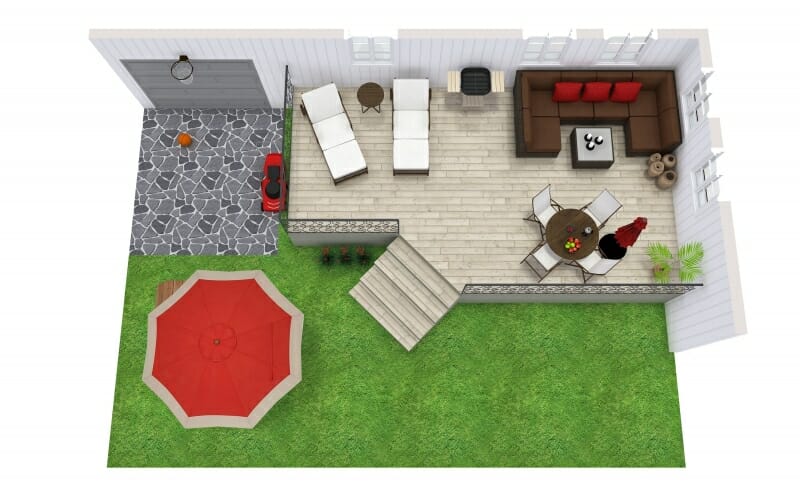
Designing a patio layout can be a daunting task, but with the right considerations, it can also be a rewarding experience. When planning your dream patio, there are several design considerations that you should keep in mind to make the most of your outdoor space.
One important consideration is the size and shape of your patio. Consider the available space in your backyard and determine how much of it you want to use for your patio. This will also dictate the shape of the patio. A squared-off or rectangular patio may be more formal, while a curved or irregularly shaped patio can give a more organic feel to the design.
The materials used in the construction of your patio are also essential. Concrete pavers, natural stone, and brick are popular choices for patio surfaces. Your choice of material should take into account the overall design of your home and landscaping, as well as the level of maintenance required for each material.
When planning your patio, it’s important to think about the desired function of the space. If you’re planning on using your patio for outdoor dining, then you will need to consider the size and placement of outdoor furniture and the location of a grill or outdoor kitchen. On the other hand, if you’re considering using your patio as a relaxing space, then you’ll want to make sure there’s enough seating and perhaps create a peaceful garden bed or plant lush potted plants in the area.
Consideration should also be given to lighting and heating. Outdoor lighting can create a warm ambiance and extend the use of the patio into the evening hours. Adding patio heaters or a fire pit can also allow you to entertain guests comfortably in cooler weather.
Finally, it’s vital to take into account your local building codes and permits. Depending on the size and complexity of your patio design, you may need to secure a building permit from your local government. Working with a professional contractor who is familiar with local regulations can help ensure your project is in compliance with all necessary requirements.
Designing a perfect patio can be a complex process, but with careful consideration, it can become a beautiful and functional space that provides you and your family with an outdoor living area to enjoy for years to come.
Size and Shape
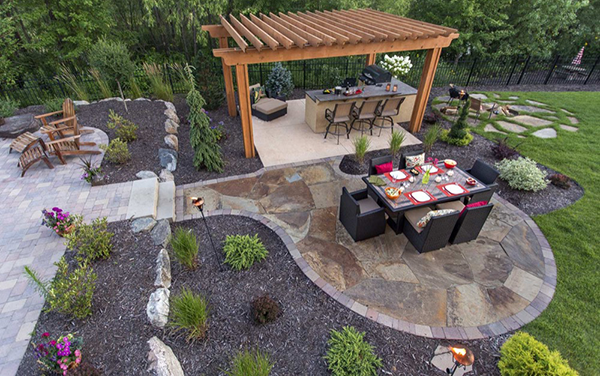
When planning your patio layout, one of the most important considerations is the size and shape of the area. The size of your patio will depend on the amount of available outdoor space in your backyard as well as your desired function for the area.
If you’re planning on using your patio as a dining space, you’ll need to ensure that there’s enough room for a table and chairs, as well as any other necessary accessories like a grill or outdoor kitchen. On the other hand, if you’re planning on using your patio as more of a lounging or relaxation space, you may be able to opt for a smaller size.
The shape of your patio is also an important consideration. A square or rectangular shape can create a more formal look and feel to your patio, while a natural or curved shape can create a more organic and fluid design. Additionally, the shape of your patio should take into account any existing landscaping or features in your outdoor area.
When deciding on the size and shape of your patio, it’s important to create a balance between form and function. While a larger patio may be more functional for entertaining, it may not fit into the overall aesthetic of your outdoor area. Conversely, a smaller patio may be more visually appealing but may not be practical for your needs.
It’s also important to consider the long-term use and maintenance of your patio. A larger patio may require more maintenance in terms of cleaning and repairs, while a smaller patio may be easier to maintain but may not accommodate all of your outdoor entertaining needs.
Ultimately, the size and shape of your patio should be customized to fit your individual needs and preferences. By considering the available space and your desired function, as well as the overall aesthetic of your outdoor area, you can create a patio that is both functional and visually appealing.
Materials
When planning your patio, one of the most important considerations is the type of materials you want to use. The right materials will not only enhance the overall look of your patio but also affect its longevity and the amount of maintenance required to keep it looking great.
One popular material for patios is natural stone. This includes options like flagstone, limestone, and sandstone. Natural stone provides a beautiful, organic look that fits well in many outdoor settings. It’s also highly durable and requires minimal maintenance. However, it can be one of the more expensive options and may not be as uniform in texture as some man-made materials.
Another common option is concrete pavers. Pavers are manufactured to be uniform in size and shape, making them easier to install than natural stone. They come in a wide range of colors and patterns, making it easy to match your patio to existing outdoor features. Pavers are also durable and easy to maintain, with the added benefit of being less expensive than natural stone.
If you’re looking for a more traditional option, brick patios are a classic choice. Bricks are durable and long-lasting, with a uniform appearance that can create a timeless look. They are also easy to maintain over time, requiring only occasional cleaning and repairs.
In addition to the materials used for the patio itself, it’s important to consider the materials for any additional features you want to include. For example, if you plan on including built-in seating or an outdoor kitchen, you’ll need to choose materials that match your patio. This could mean using natural stone or bricks for a cohesive look.
When selecting your materials, make sure to consider both the practical and aesthetic benefits and drawbacks. Ultimately, the right choice will depend on your budget, personal preferences, and the overall style and functionality of your outdoor space. With the right materials, your patio will be a beautiful and functional addition to your home for years to come.
Furniture and Accessories
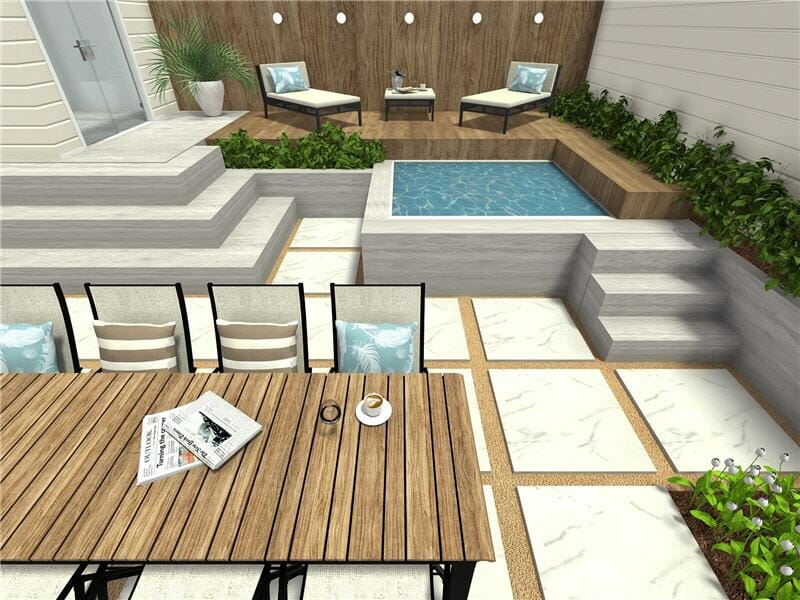
When designing your patio space, it’s important to consider the furniture and accessories that will bring your outdoor living area to life. Whether you plan on lounging by the pool, entertaining guests, or simply enjoying a quiet afternoon with a book, the right furniture and accessories can make all the difference in creating a comfortable, welcoming space.
One of the key considerations in selecting outdoor furniture is the material. Furniture made from materials like metal, teak, or wicker can be both durable and stylish, and are well-suited for outdoor use. These materials are able to withstand the elements, and can be easily cleaned with a quick wipe-down. Additionally, plush cushions can be added to seating areas to provide extra comfort and lend a cozy feel to the space.
When choosing outdoor accessories, it’s important to think about both aesthetics and function. Lighting is a crucial component in creating a welcoming atmosphere, and options like string lights or lanterns can add a soft glow to the space. A well-placed umbrella or shade sail can also provide relief from the sun’s rays on hot days, while outdoor curtains can add privacy and enhance the ambiance.
For those with a green thumb, incorporating plants and garden beds into your patio space can add color and texture. Potted plants are great for smaller patios, while raised garden beds can be a beautiful addition to larger spaces. Surrounding yourself with lush greenery can create a relaxing, natural oasis where you can unwind and recharge.
Finally, accessorizing with items like outdoor rugs, throw pillows, and artwork can personalize your patio and make it feel like an extension of your indoor space. Coordinating colors and patterns can create a cohesive look, while adding unexpected elements like a statement piece of art can bring character and charm to the area.
Overall, selecting the right furniture and accessories can truly elevate your patio space and make it a place you’ll want to spend time in for years to come. Whether you prefer a modern, streamlined look or a cozy, traditional vibe, with a little creativity and attention to detail, you can design the patio of your dreams.
Accessibility, Privacy and Visibility Concerns

Accessibility, privacy, and visibility are three key considerations when planning any outdoor space, especially a patio. Balancing these factors can be a challenge, but with careful planning and design, it is possible to create a patio that meets all of your needs.
Accessibility refers to the ease of access to and from your patio. It is important to consider factors like the location of the patio in relation to the house and any existing pathways or walkways. If your patio is going to be used frequently, it is important to ensure that it is easily accessible from both inside and outside the house. This means planning a layout that incorporates clear pathways and minimal steps or obstacles.
Privacy is another important consideration, particularly if your patio is in a communal area or near a main road. While some people may enjoy being in a more public space, others may prefer a more secluded area. Strategically placed plants, fencing, or screening can help to create a sense of privacy while still allowing natural light and fresh air to flow through the space.
Visibility is also important when it comes to designing a patio. You want to be able to enjoy any views from your patio, while at the same time controlling the amount of light and glare that may be coming into the space. The positioning of any windows or doors in relation to the patio should also be considered, as it can affect the overall look and feel of the space.
When considering accessibility, privacy, and visibility in your patio design, it is important to think about your individual needs and preferences. Consulting with a landscape designer or architect can be helpful in creating a space that meets all of these requirements while still reflecting your personal style. By taking these factors into account, you can create a patio that is both functional and beautiful, and a space you can truly enjoy.
Building Codes and Regulations

When planning any construction project, it is important to consider the local building codes and regulations that apply in your area. Building codes are legal requirements that have been put in place by local governments to ensure safety and well-being of the people who will use the building or structure. While building codes and regulations may vary from state to state and even between towns, they all aim to promote and enforce a minimum level of safety within the built environment.
One of the benefits of adhering to building codes is that it helps to protect people from potential hazards. For example, building codes for fire safety require that structures have fire alarms, evacuation routes, and adequate emergency exits. Such requirements can save countless lives in case of a fire emergency.
Building codes also ensure that structures are built to last. Codes often dictate minimum standards for materials, design, and construction methods. If these requirements are not met, buildings may be more susceptible to damage in the event of natural disasters like earthquakes or hurricanes.
While it may seem like a hassle to navigate building codes when planning your construction project, following these regulations is not only a legal requirement but can also provide several benefits, including the protection of life and property, and the assurance of structural safety.
However, it is essential to note that building codes are a minimum standard and should not be seen as a limit. Builders can still use their skills and creativity to design and construct buildings that exceed the minimum requirements. With the guidance of a trusted professional and compliance to building codes, you can ensure that your building is not only safe, but also functional, efficient, and aesthetically pleasing.
Design Strategies for a Patio Layout
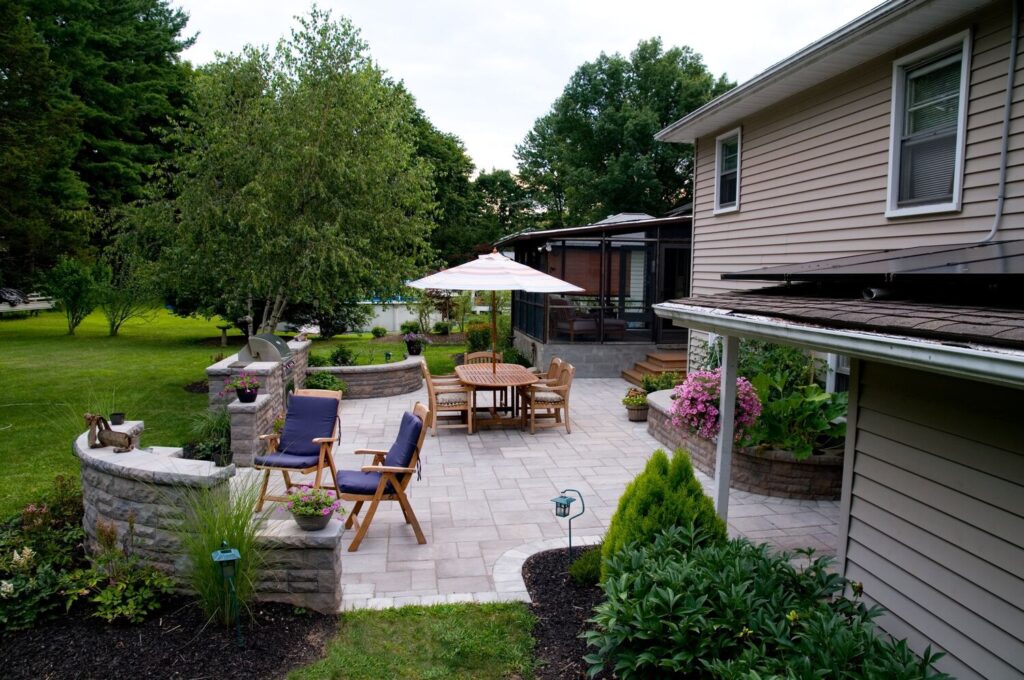
Designing a patio layout is an exciting task that allows you to create an outdoor living space where you can relax and entertain. Whether you’re starting from scratch or revamping an existing patio, here are some design strategies to help you plan the perfect layout.
1. Determine the size of your patio:
Before starting the design process, you need to determine the size of your patio. Consider the available space and how you plan to use the patio. If you want to use it for dining and entertaining, make sure to allocate enough space for a table and chairs. If you plan to use it for relaxation, leave space for comfortable seating.
2. Choose your patio materials:
The materials used for your patio will have a significant impact on the final design. Consider using materials like natural stone or concrete pavers for a classic look. Alternatively, you can opt for brick or stamped concrete for a unique aesthetic appeal. Ensure that the materials you choose are durable and suitable for the weather conditions in your area.
3. Incorporate outdoor furniture:
Outdoor furniture is an essential part of a patio layout. Ideally, you should select seating that is comfortable and durable. Consider using sectional sofas and lounge chairs if you have ample space. If your patio is small, opt for bench-style seating or foldable chairs that can be stored when not in use.
4. Add outdoor lighting:
Adding outdoor lighting is an excellent way to create ambiance and enhance the functionality of your patio. You can consider using string lights to create a cozy atmosphere or installing patio post lights to illuminate the area. Consider using sensor lights to provide illumination when you walk out to the patio at night.
5. Incorporate built-in features:
Built-in features like fire pits, grills, and water features can add functionality and ambiance to your patio. These features should be well-designed and complement the overall look and feel of your outdoor space.
In conclusion, when planning a patio layout, it’s essential to consider how you will use the space, choose suitable materials, incorporate outdoor furniture and lighting, and incorporate built-in features. With these design strategies in mind, you can create a functional and stylish outdoor living space that you and your loved ones can enjoy throughout the year.
Defining the Space with Built-In Seating or Structures
When it comes to designing your perfect patio, creating a defined space is key to maximizing its potential. One great way to do this is by incorporating built-in seating or structures. By incorporating these elements into your patio design, you can create an inviting and functional space that is perfect for entertaining friends and family.
Built-in seating can take many forms, including benches, chairs, and even sofas. These features not only add extra seating for guests, but also help to define the space of your patio. Built-in seating can also be used to create intimate nooks and conversation areas within the larger space, perfect for enjoying a glass of wine with a friend or family member.
Another great option for defining your patio space is by incorporating built-in structures like pergolas or trellises. These structures can be used to provide shade, add height and interest to the space, and create a sense of enclosure. By integrating plants or vines into these structures, you can also add a touch of natural beauty to your patio design.
When incorporating built-in features into your patio design, it’s important to consider the overall style and aesthetic of your space. Whether you prefer a modern, minimalist look or a more traditional, cozy feel, there are built-in options that can enhance your design and add functionality to your patio.
Ultimately, built-in seating and structures are an excellent way to define your patio space and create a welcoming environment for guests. By considering these design elements in your patio layout, you can make the most of your outdoor living space and create a beautiful, functional oasis that you’ll love for years to come. You can also consider deep seating furniture for entertaining guests
Creating Multiple Levels of Patios
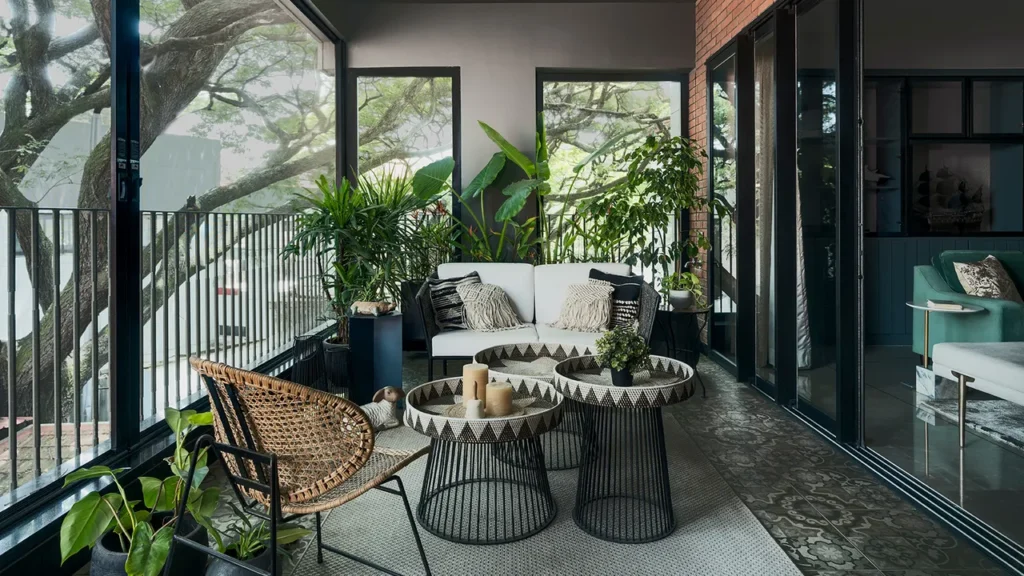
Designing a patio can be a fun and exciting project, especially if you’re looking to create a multi-level outdoor space that is both functional and visually stunning. Multiple levels can add depth, dimension, and interest to your patio, creating a unique and inviting atmosphere for you and your guests to enjoy.
One of the first things to consider when designing multi-level patios is the purpose of each level. Each level should serve a specific purpose, whether it be a relaxing space for lounging, a dining area for outdoor entertaining, or a cozy nook for intimate conversations.
To achieve this, you’ll need to carefully plan out the different levels of your patio and how they’ll be used. Consider the size and shape of your patio space, as well as any existing landscape or hardscape features that may need to be worked around.
When it comes to materials for your multi-level patio, there are many options to choose from. Natural stone, concrete pavers, and brick are all popular choices for creating different levels and defining separate areas of your patio. Keep in mind that each level may benefit from a different type of material, depending on its intended purpose and the overall aesthetic you’re trying to achieve.
Another key consideration when designing multi-level patios is accessibility. You’ll want to make sure each level is easy to navigate and that the transitions between levels are seamless and safe. This may require the addition of steps, ramps, or even a small retaining wall if there is a significant height difference between levels.
One of the benefits of creating multiple levels in your patio design is that it allows you to incorporate additional features and elements that can enhance the overall function and enjoyment of your outdoor space. This may include built-in seating, outdoor kitchens, fire pits, water features, or even garden beds or planters.
Regardless of the specific features you choose to include in your multi-level patio design, it’s important to work closely with a professional landscape designer or contractor to ensure that your vision for your outdoor space is executed with precision and expertise. With careful planning and attention to detail, you can create a multi-level patio that is both functional and beautiful, providing endless hours of enjoyment for you and your loved ones.
Utilizing Different Materials to Create Interest
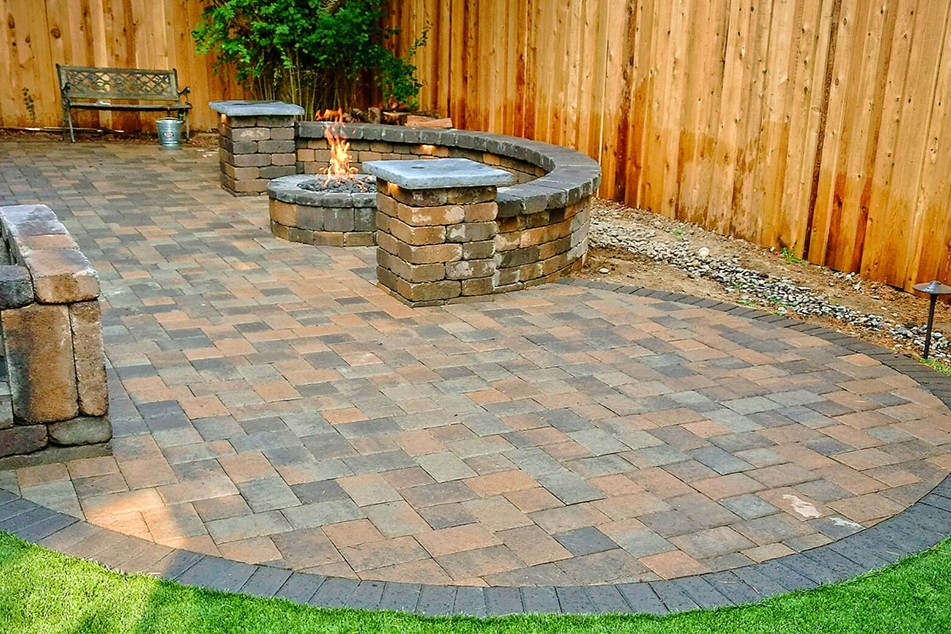
When it comes to designing your outdoor living space, choosing the right materials can make all the difference. By utilizing different materials, you can create interest, texture, and depth in your design, taking your patio from a cookie-cutter look to a beautiful, unique outdoor oasis.
One way to incorporate different materials into your patio design is by choosing a mix of natural stone and concrete pavers. Natural stone offers a timeless, organic feel, while concrete pavers provide a sleek, modern touch. By blending the two, you can create a space that feels simultaneously classic and contemporary.
Another method for utilizing different materials in patio design is through the use of accent pieces. Consider adding a pop of color or texture with brightly colored throw pillows, a woven outdoor rug, or a unique piece of artwork. Mixing and matching patterns and textures can create depth and interest, taking your patio from a boring, one-dimensional look to something that feels truly special.
Incorporating outdoor furniture in a range of materials can also enhance the visual appeal of your patio. Consider mixing wood and metal pieces for a rustic-meets-modern look, or blending wicker furniture with sleek metal accents for a more coastal vibe. Additionally, incorporating built-in furniture, such as a stone bench, can add architectural interest to your space.
Finally, don’t forget about the importance of lighting and landscaping in enhancing your patio design. Incorporating soft, warm lighting can create a cozy, inviting atmosphere, while lush plants and garden beds can add a touch of natural beauty. Consider including potted plants or an herb garden for added interest and fragrance.
In conclusion, utilizing different materials is a key way to take your patio design from drab to fab. Whether it’s through a mix of natural stone and concrete pavers, accent pieces, varied furniture materials, or thoughtful lighting and landscaping, adding interest and depth to your outdoor living space will help create a true oasis in your own backyard.
Incorporating Outdoor Lighting in the Design
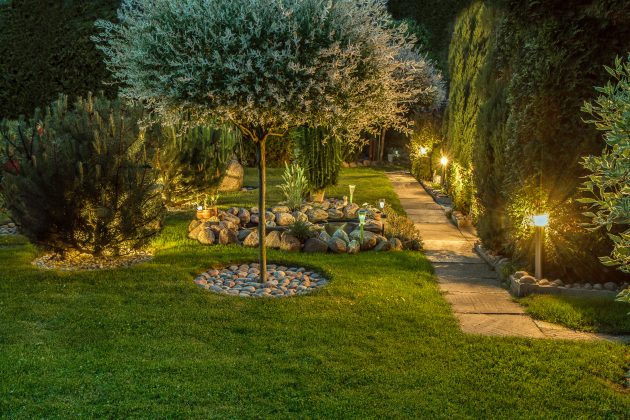
Incorporating outdoor lighting can take your patio from a functional space to a truly magical one. When it comes to designing your outdoor living space, lighting is just as important as furniture and decor. It not only adds an element of safety and security, but it also creates a warm, inviting atmosphere for you and your guests to enjoy.
First and foremost, you’ll want to consider the types of lighting you’ll be using. There are a variety of options available to choose from, including string lights, spotlights, post lights, and more. It’s important to select lighting that not only complements your patio design, but that also serves a practical purpose.
One key aspect to keep in mind when planning your outdoor lighting is to create layers of light. Just as you would in your indoor living space, combining different types of lighting can create depth and interest. For instance, string lights can create a cozy ambiance, while spotlights can highlight certain features of your patio, such as a beautiful garden or water feature.
Another important aspect to consider is the placement of your lighting fixtures. You’ll want to strategically place lights to ensure a well-lit, safe environment that also showcases your patio’s best features. For example, post lights can guide guests to the patio entrance, while ground lights can illuminate walkways and stairs.
When it comes to choosing the right lighting fixtures, it’s important to consider both the style and functionality of the space. Some popular options include solar-powered lights, which are eco-friendly and cost-efficient, or low-voltage lights, which can be easily installed and customized to fit your specific needs.
Overall, incorporating outdoor lighting into your patio design is essential to creating a welcoming and functional space. With a variety of lighting options available, you can easily add a touch of magic to your outdoor living space while also ensuring safety and security. So, whether you’re entertaining guests or simply enjoying a peaceful evening outside, outdoor lighting is a must-have in any patio design.
Adding Extra Space with Storage Solutions
Landscaping Your Patio Layout
If you’re looking to enhance your outdoor living space, then creating a well-planned patio layout is the way to go. A beautifully landscaped patio not only adds value to your property, but it also serves as a perfect spot to relax and entertain guests. However, planning and designing a patio layout can seem daunting, especially if you’re unsure of where to start. In this article, we’ll walk through a few essential steps to help you create a patio space that you’ll love.
First and foremost, consider the size of your patio. Before getting into the details of patio furniture, outdoor lighting, and landscape design, you need to determine the square footage, shape, and location of your patio area. Measuring your available space will help you plan the perfect layout and ensure it fits your needs.
Next, figure out the function and purpose of the patio. Decide whether you want to use it for relaxation, hosting outdoor dinners, or both. Determining this will help to guide your decisions around patio design.
Now comes the fun part – designing your patio! Come up with a rough sketch or use an online patio designer to map out your ideas. Ensure that the patio layout not only accommodates your needs but also complements your home’s architecture and style.
The type of materials used in your patio is also crucial. From natural stone, brick, and pavers to concrete slabs, there are various materials to choose from, so select what works best for your needs and budget. You can also add features like a built-in seating area or outdoor dining table to enhance the functionality of your patio.
Lastly, don’t forget about landscaping your patio space. Incorporating lush plants, potted plants, and garden beds will help to create a beautiful and relaxing ambiance. Not only that, but it’ll also provide privacy and shade while adding life to your outdoor living space. Additionally, adding outdoor lighting can help to create a warm and inviting atmosphere even during nighttime.
In conclusion, by following these steps, you’ll be able to create the perfect patio layout that not only looks aesthetically pleasing but is also functional and meets all of your outdoor living needs. With careful planning and consideration, your patio space can become your dream outdoor living area.

